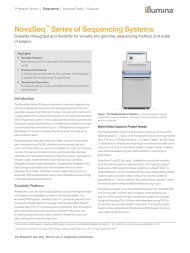Abstracts
ngsfinalprogram
ngsfinalprogram
You also want an ePaper? Increase the reach of your titles
YUMPU automatically turns print PDFs into web optimized ePapers that Google loves.
Poster <strong>Abstracts</strong><br />
n 72<br />
TRANSFORMING PUBLIC HEALTH<br />
MICROBIOLOGY FOR CAMPYLOBACTER<br />
WITH WHOLE GENOME SEQUENCING:<br />
PULSENET AND BEYOND<br />
J. Pruckler 1 , D. Wagner 1 , G. Williams 1 , H.<br />
Carleton 1 , C. Bennett 1 , L. Joseph 1 , E. Trees 1 ,<br />
A. Huang 1 , L. S. Katz 1 , L. Gladney 1 , M. C.<br />
Maiden 2 , W. Miller 3 , Y. Chen 4 , S. Zhao 4 , P.<br />
McDermott 4 , J. Whichard 1 , H. Pouseele 5 , E. M.<br />
Ribot 1 , C. Fitzgerald 1 , P. Gerner-Smidt 1 ;<br />
1<br />
Centers for Disease Control and Prevention,<br />
Atlanta, GA, 2 University of Oxford, Oxford,<br />
UNITED KINGDOM, 3 United States Department<br />
of Agriculture, Albany, CA, 4 United States<br />
Food and Drug Administration, Laurel, MD,<br />
5<br />
Applied Maths, Inc., Sint-Martens-Latem,<br />
BELGIUM.<br />
Background: Conventional phenotypic and<br />
genotypic methods employed for identification<br />
and subtyping of Campylobacter are labor<br />
intensive, expensive, and imprecise. We have<br />
begun development of Enteric Reference Identification<br />
and Campylobacter subtype characterization<br />
whole genome sequence (WGS)<br />
databases. The PulseNet infrastructure (BioNumerics)<br />
will be used in conjunction with the<br />
existing BIGSdb platform to build the databases,<br />
with the goal of characterizing Campylobacter<br />
in a single workflow using WGS.<br />
Methods: Reference genomes (n=103) provided<br />
by FDA and USDA and strains (n=100)<br />
sequenced at CDC were used to develop the<br />
database. Assemblies and annotations were<br />
performed using the Computational Genomics<br />
Pipeline v0.4. These genomes cover the known<br />
members of the species and genera within<br />
Campylobacteraceae and the known genetic<br />
diversity of C. jejuni. The data will be used<br />
to set criteria for the current PubMLST.org/<br />
campylobacter locus definitions. Multiple subschema<br />
are being set up within the databases to<br />
perform identification and scalable, hierarchical<br />
subtyping that will include seven locus,<br />
ribosomal, core genome and whole genome<br />
(MLST, rMLST, cgMLST and wgMLST).<br />
Results: To date 203 reference genomes<br />
have been sequenced, annotated and used for<br />
development of the BioNumerics databases<br />
including an additional 600 isolates that are<br />
being used to validate the prototype databases.<br />
Conclusions: These WGS BioNumerics<br />
databases will provide a single, unified, costeffective<br />
approach for accurate species identification<br />
and subtyping to aid the surveillance of<br />
sporadic and outbreak related Campylobacter<br />
infections. Through continued collaboration<br />
with domestic and international partners, we<br />
will test and refine the nomenclature, databases<br />
and CLIA validate the reference identification<br />
subschema within the next year.<br />
n 73<br />
METAGENOMIC PATHOGEN DETECTION AND<br />
GUT MICROBIOME RESPONSE TO ACUTE<br />
SALMONELLA INFECTION<br />
A. D. Huang 1 , M. R. Weigand 1 , A. Pena-Gonzalez<br />
2 , K. T. Konstantinidis 2 , C. L. Tarr 1 ;<br />
1<br />
Centers for Disease Control and Prevention,<br />
Atlanta, GA, 2 Georgia Institute of Technology,<br />
Atlanta, GA.<br />
Background: Current diagnostic testing<br />
for bacterial foodborne pathogens relies on<br />
culture-based techniques even though many<br />
microorganisms, including known pathogens,<br />
cannot be cultured. Powerful sequence-based<br />
approaches such as metagenomics have potential<br />
to derive epidemiologically-relevant<br />
information directly from complex samples,<br />
bypassing the need to isolate individual organisms.<br />
However, such methods have not been<br />
systematically applied to foodborne pathogen<br />
detection because standardized bioinformatics<br />
techniques for analysis have not been established.<br />
Methods: We applied shotgun metagenomics<br />
to anonymized residual stool samples<br />
collected from foodborne outbreaks attributed<br />
88<br />
ASM Conferences



